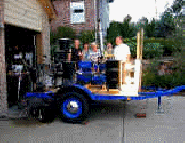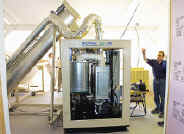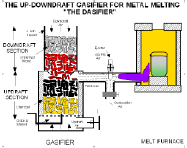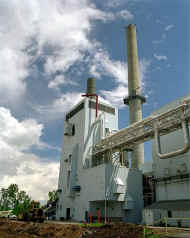|


|
"Woodgas" is my name for the various gases that can be easily made from
wood or biomass. Various forms are: synthesis gas,
typically 40% hydrogen, H2, 40% carbon monoxide, CO, 3% methane, and 17%
Carbon dioxide; producer gas, made by gasifying biomass with air
(and therefore containing ~50% nitrogen); pyrolysis gas, similar
to synthesis gas, but including lots or water and tar and
accompanied by production of 10-30% charcoal.
The Industrial Revolution was
fueled by gas starting in 1800 (primarily from coal
by pyrolysis) initially used for city and home lighting,
then for cooking and power generation. Coke
for steel making was a useful by-product. By 1850, the major
cities of the world had "gaslight" (see Dickens
novels). The internal combustion engine was
invented to make electricity from producer
gas about 1880. See all the wonderful
old coal systems in our book "Modern Gas Producers" on
our Books
page. All of this changed starting in 1930, when welded
pipelines brought natural gas from oil wells to
our houses and now few of us remember the producer gas
(manufactured gas, city
gas, water gas etc.) era.
During World War II over a
million gasifiers were built for the civilian sector while the
military used up all the gasoline. Now that world oil supplies
are being depleted and global warming is perceived as a threat
to our environment, there is renewed interest in gas from
BIOMASS. The National Academy of Sciences published a
great booklet on "Producer Gas: Another Fuel for Motor
Transport" in 1983, and we are into our third printing at
the BEF PRESS (see BEF Books).
We show here a few interesting old pictures from that book. (Click
each thumbnail to view large and return here with Back button)
and a few more
modern ones from the late 1970s-early 80s.
Old & Modern
Gasifiers
On March 9, 2001 I
visited a Mr. Mel Strand at his home in Boulder, CO. Mel
was born in Minneapolis, but during WWII he was stranded in
Norway during the occupation and drove a gasifier truck -
delivering groceries in the day and weapons to the underground
at night.
Mel returned
to the U.S. after the war and his career has been in machining
and fabrication. As a hobby a few years ago he decided to
construct the gasifier he remembered it from a 1948 Chevy
pickup. What a beauty he made!
Mel turned on the
auxiliary starting fan, and started the gasifier on large aspen
chunks with a newspaper. After a few minutes he lit the
gas at the front of the truck and started the engine. We
drove around Colorado Springs for several hours. I
realized what an art it was to drive a gasifier car, since he
could control the spark advance, air fuel ratio and throttle,
all from the steering column, while talking about the old and
new days.
Modern Small
Gasifiers
| A great deal of
development of gasifiers is going on around the world.
In
1999 I collaborated with the
company Community Power, CPC,
Corporation, CPC, to build a 5 kW
"Turnkey, Tarfree" gasifier using new principles I had
discovered and learned. The picture at the right shows
Kurt Kirscher, Shivayam Ellis, myself, Agua Das and Robb Walt
(President of CPC) outside my laboratory.
|
 |
CPC
developed this gasifier with the aid of grants from the US DOE,
Shell International, the California Energy commision ant others
into field gasifiers tested in Alaminos in the Philippines and
the Hoopa Valley Indian Reservation in California.
CPC
is now quite active in many aspects of gasifier research and has
a dozen 15 kW "Turnkey, Tarfree" gasifiers in the
field and used by the US Forest Service and Others to turn
forest litter and biomass trash into heat and power. CPC is now
also developing a 5 kW heat/power and a 50 kW gasifier.
|
 |
|
THE DASIFIER
FOUNDRY GASIFIER
Here's a nifty
gasifier developed by my colleague and
co-author, Agua Das, for melting bronze and other metals
with biomass. Built from tincans and a
refrigerator compressor, it burns all kinds of biomass trash.
I also call it an "up-down draft gasifier. See
the description at "Dasifier".
|

|
BIG GASIFIERS
I have lots of
descriptions of large gasifier projects in my book "Survey
of Biomass Gasification - 2000" (see Books).
Here is the famous Burlington Vt. 5 MW fluidized bed that makes
a very rich gas of 15 MJ/m3. It is based
on the double fluidized bed developed at Battelle and has been
scaled up by FERCO and the US Dept. of Energy. It operates
on wood chips from the Vermont forests. I
believe it is no longer in operation (July, 2004).
The BEF is involved
with research, design and construction of all gasifier sizes.
|
 |
GASIFIERS FOR
FUELS AND CHEMICALS
When biomass is
gasified with air the resulting gas has ~50% nitrogen,
and so is good only for use at the point of origin. For
pipelines, for some storage or for chemical synthesis,
oxygen gasification produces a gas
with twice the energy (~12 MJ/m3) while pyrolytic
gasification can produce a gas with 20 MJ/m2.
In 1973 at
MIT, I wrote the lead article for the journal Science,
"Methanol:
A versatile Fuel for Immediate Use", (Vol. 182, pp 1299,
1973). Unfortunately,
the US chose not to develop fuels alternative to gasoline and so
has been exporting money for oil to finance terrorists.
Read the sad story at our Methanol
page.
In 1980 we built an
oxygen gasifier at SERI/NREL which eventually was tested on pure
oxygen at the 25 ton/d level. This is discussed in our
book FUNDAMENTAL STUDY AND SCALE UP OF THE AIR-OXYGEN STRATIFIED
DOWNDRAFT GASIFIER on the Books
Page.
|